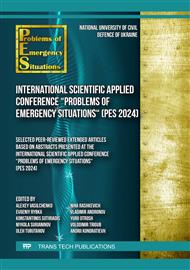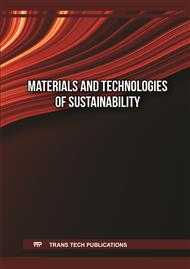[1]
S. Ragimov, V. Sobyna, S. Vambol, V. Vambol, A. Feshchenko, A. Zakora, E. Strejekurov, V. Shalomov, Physical modelling of changes in the energy impact on a worker taking into account high-temperature radiation, Journal of Achievements in Materials and Manufacturing Engineering, 91/1 (2018) 27–33.
DOI: 10.5604/01.3001.0012.9654
Google Scholar
[2]
S. Vambol, V. Vambol, I. Bogdanov, Y. Suchikova, N. Rashkevich, Research of the influence of decomposition of wastes of polymers with nano inclusions on the atmosphere, Eastern-European Journal of Enterprise Technologies, 6/10(90) (2017) 57–64.
DOI: 10.15587/1729-4061.2017.118213
Google Scholar
[3]
V. Sadkovyi, at al, Construction of a method for detecting arbitrary hazard pollutants in the atmospheric air based on the structural function of the current pollutant concentrations, Eastern-European Journal of Enterprise Technologies, 6(10) (2020) 14–22.
DOI: 10.15587/1729-4061.2020.218714
Google Scholar
[4]
S. Vambol, V. Vambol, O. Kondratenko, V. Koloskov, Y. Suchikova, Substantiation of expedience of application of high-temperature utilization of used tires for liquefied methane production, Journal of Achievements in Materials and Manufacturing Engineering, 87/2 (2018) 77–84.
DOI: 10.5604/01.3001.0012.2830
Google Scholar
[5]
S. Vambol, V. Vambol, V. Sobyna, V. Koloskov, L. Poberezhna, Investigation of the energy efficiency of waste utilization technology, with considering the use of low-temperature separation of the resulting gas mixtures, Energetika, 64/4 (2018) 186–195.
DOI: 10.6001/energetika.v64i4.3893
Google Scholar
[6]
I.F. Dadashov, V.M. Loboichenko, V.M. Strelets, M.А. Gurbanova, F.M. Hajizadeh, A.І. Morozov, About the environmental characteristics of fire extinguishing substances used in extinguishing oil and petroleum products, SOCAR Proceedings, 5 (2020) 79–84.
DOI: 10.5510/ogp20200100426
Google Scholar
[7]
V.V. Strelets, V. Loboichenko, N.Leonova, R. Shevchenko, V.M. Strelets, A. Pruskyi, O. Avramenko, Comparative assessment of environmental parameters of foaming agents based on synthetic hydrocarbon used for extinguishing the fires of oil and petroleum products, SOCAR Proceedings, 2 (2021) 1–10.
DOI: 10.5510/ogp2021si200537
Google Scholar
[8]
I. Glassman, R.A. Yetter, Combustion, London, Elsevier, 2014.
Google Scholar
[9]
B. Pospelov, at al, Development of The Method of Operational Forecasting of Fire in the Premises of Objects Under Real Conditions, Eastern-European Journal of Enterprise Technologies, 2 (2021) 43–50.
DOI: 10.15587/1729-4061.2021.226692
Google Scholar
[10]
S.S. Kaim, S.D. Kaim, R. Rojek, Mechanism of "Hot Points" Generation in Fronts of Detonation Waves in Condensed Energetic Materials, Nanosyst. Nanomater. Nanotechn, 7(4) (2009) 1201–1226.
Google Scholar
[11]
O. Zavialova, at al, Theoretical basis for the formation of damaging factors during the coal aerosol explosion, Mining of Mineral Deposits, 15/4 (2021) 130–138.
DOI: 10.33271/mining15.04.130
Google Scholar
[12]
S.D. Kaim, Nano Gas dynamics of gas and dust emissions in coal mines, Nanosystems. Nanomaterials. Nanotechnologies, 10(3) (2012) 609–628.
Google Scholar
[13]
H. Zhu, K. Sheng, Y. Zhang, S. Fang, Y. Wu, The stage analysis and countermeasures of coal spontaneous combustion based on "five stages" division, PLoS One, 13(8) (2018) e0202724.
DOI: 10.1371/journal.pone.0202724
Google Scholar
[14]
B. Pospelov, V. Andronov, E. Rybka, V. Popov, O. Semkiv, Development of the method of frequencytemporal representation of fluctuations of gaseous medium parameters at fire, Eastern-European Journal of Enterprise Technologies, 2(10–92) (2018) 44–49.
DOI: 10.15587/1729-4061.2018.125926
Google Scholar
[15]
A.A. Levterov, Acoustic Research Method for Burning Flammable Substances, Acoustical Physics, 65(4) (2019) 444–449.
DOI: 10.1134/s1063771019040109
Google Scholar
[16]
B. Pospelov, E. Rybka, R. Meleshchenko, S. Gornostal, S. Shcherbak, Results of experimental research into correlations between hazardous factors of ignition of materials in premises, Eastern-European Journal of Enterprise Technologies, 6(10–90) (2017) 50–56.
DOI: 10.15587/1729-4061.2017.117789
Google Scholar
[17]
D. Dubinin, at al, Numerical simulation of the creation of a fire fighting barrier using an explosion of a combustible charge,Eastern-European Journal of Enterprise Technologies, 6(10–90) (2017) 11–16.
DOI: 10.15587/1729-4061.2017.114504
Google Scholar
[18]
K. Korytchenko at al, Experimental research into the influence of twospark ignition on the deflagration to detonation transition process in a detonation tube, East.-European J. of Enterprise Technol., 4 (2019) 26–31.
DOI: 10.15587/1729-4061.2019.175333
Google Scholar
[19]
K. Korytchenko, A. Ozerov, D. Vinnikov, Y. Skob, D. Dubinin, R. Meleshchenko, Numerical simulation of influence of the non-equilibrium excitation of molecules on direct detonation initiation by spark discharge, Problems of Atomic Science and Technology, 116(4) (2018) 194–199.
DOI: 10.46813/2021-134-171
Google Scholar
[20]
K. Korytchenko, O. Sakun, Y. Khilko, D. Dubinin, E. Slepuzhnikov, A. Nikorchuk, I. Tsebriuk, Experimental investigation of the fireextinguishing system with a gasdetonation charge for fluid acceleration, Eastern-European Journal of Enterprise Technologies, 3(9–93) (2018), 47–54.
DOI: 10.15587/1729-4061.2018.134193
Google Scholar
[21]
O. Kondratenko, S. Vambol, O. Strokov, A. Avramenko. Mathematical model of the efficiency of diesel particulate matter filter. Naukovyi Visnyk Natsionalnoho Hirnychoho Universytetu, 6 (2015) 55–61.
Google Scholar
[22]
B. Pospelov, V. Andronov, E. Rybka, R. Meleshchenko, P. Borodych, Studying the recurrent diagrams of carbon monoxide concentration at early ignitions in premises, Eastern-European Journal of Enterprise Technologies, 3(9–93) (2018), 34–40.
DOI: 10.15587/1729-4061.2018.133127
Google Scholar
[23]
A. Yaxin, K. B. Karteek, A.D. Sanket, Development of New Transferable Coarse-Grained Models of Hydrocarbons, J. Phys. Chem., 122(28) (2018) 7143–7153.
DOI: 10.1021/acs.jpcb.8b03822
Google Scholar
[24]
A.S. Olson, A.J. Jameson, S.K. Kyasa, B.W. Evans, P.H. Dussault, Reductive Cleavage of Organic Peroxides by Iron Salts and Thiols, ACS omega, 3(10) (2018) 14054–14063.
DOI: 10.1021/acsomega.8b01977
Google Scholar
[25]
J.E. House, Inorganic Chemistry, California, Elsevier, 2010.
Google Scholar
[26]
B. Pospelov, V. Andronov, E. Rybka, V. Popov, A. Romin, Experimental study of the fluctuations of gas medium parameters as early signs of fire, East.-Europ. J. of Enterprise Technologies, 1(10–91) (2018) 50–55.
DOI: 10.15587/1729-4061.2018.122419
Google Scholar
[27]
B. Pospelov, V. Andronov, E. Rybka, R. Meleshchenko, S. Gornostal, Analysis of correlation dimensionality of the state of a gas medium at early ignition of materials, Eastern-European Journal of Enterprise Technologies, 5(10) (2018) 25–30.
DOI: 10.15587/1729-4061.2018.142995
Google Scholar
[28]
D. Tregubov, O. Tarakhno, V. Deineka, F. Trehubova, Oscillation and Stepwise of Hydrocarbon Melting Temperatures as a Marker of their Cluster Structure, Solid State Ph., 334 (2022) 124–130.
DOI: 10.4028/p-3751s3
Google Scholar
[29]
Quickly find chemical information from authoritative sources, Pubchem, U.S. National Library of Medicine. Information on https://pubchem.ncbi.nlm.nih.gov/.
Google Scholar
[30]
D. Tregubov, E. Slepuzhnikov, M. Chyrkina, A. Maiboroda, Cluster Mechanism of the Explosive Processes Initiation in the Matter, Key Engineering Materials, 952 (2023) 131–142.
DOI: 10.4028/p-lzz2hq
Google Scholar
[31]
D. Tregubov, I. Dadashov, V. Nuianzin, O. Khrystych, N. Minska, Relationship Between Properties of Floating Systems and Flammable Liquids in the Stopping Their Burning Technology, Key Engineering Materials, 954 (2023) 145–155.
DOI: 10.4028/p-krzrd9
Google Scholar
[32]
Yu. Hapon, D. Tregubov, E. Slepuzhnikov, V. Lypovyi, Cluster Structure Control of Coatings by Electrochemical Coprecipitation of Metals to Obtain Target Technological Properties, Solid State Ph., 334 (2022) 70–76.
DOI: 10.4028/p-4ws8gz
Google Scholar
[33]
N. Gaston, Cluster melting: new, limiting, and liminal phenomena, Adv. Physics, 3(1) (2018) 1401487.
DOI: 10.1080/23746149.2017.1401487
Google Scholar
[34]
Q. Jiang, S. Zhang, M. Zhao, Size-dependent melting point of noble metals, Materials Chemistry and Physics, 82(1) (2003) 225–227.
DOI: 10.1016/s0254-0584(03)00201-3
Google Scholar
[35]
Search for Species Data by Chemical Name, NIST Chemistry WebBook, U.S. Department of Commerce. Information on.
Google Scholar
[36]
A. Nassimi, M. Jafari, H. Farrokhpour, M.H. Keshavarz, Constants of explosive limits, Chemical Engineering Science, 173(2) (2017) 384–389.
DOI: 10.1016/j.ces.2017.08.011
Google Scholar
[37]
J.R. Rowley, J.E. Bruce-Black, Proper application of flammability limit data in consequence studies, Hazards XXIII. Symposium Series, 158 (2012) 443–452.
Google Scholar
[38]
J.R. Rowley, Flammability Limits, Flash Points, and Their Consanguinity: Critical Analysis, Experimental Exploration, and Prediction, A dissert. for the degree of Doct. of Phil., BYU, Provo, 2010.
Google Scholar
[39]
C.-C. Chen, A Study on Estimating Flammability Limits in Oxygen, Ind. Eng. Chem. Res., 50 (2011) 10283–10291.
DOI: 10.1021/ie102373g
Google Scholar



